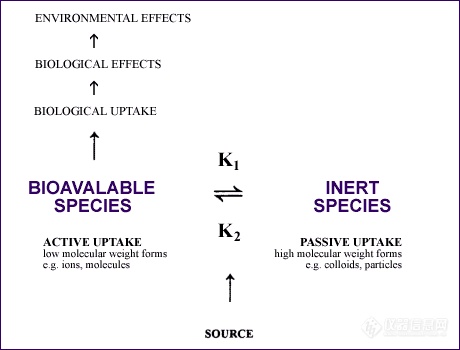Contamination From Speciation Change:
Trace metals associated with colloids and particles are considered inert4;
The sampling scheme should involve separation of these various forms of metal species in situ or shortly after sampling.
The quality of a representative water sample can be defined as the degree to which the sample retains its composition and properties after the removal from the original environment.
For trace elements, the main factors affecting the quality are contribution of elements due to contamination and loss of species due to sorption and volatilization.
The key point is that contamination can come from the breakdown of "inert" colloids / particles. The following figure illustrates this sample collection contamination issue:
Figure 3.1: The Breakdown of "Inert" Colloids / Particles
![]()
The ability to differentiate between phsico-chemical forms is essential for assessing biological uptake of trace elements...
"Following the introduction of non-contaminating techniques for sampling, sample handling, and analysis, as well as developments within analytical techniques and instruments, the concentration levels of trace elements in unpolluted natural waters have been shown to be a factor of 10 to 1000 lower than previously accepted. Thus, the progress made in our understanding of trace element behavior in natural water systems is closely related to improvements within analytical chemistry."4
1. J. Versieck, L. Vanballenberghe, A. De Kese, D. VanRenterghem, Biological Trace Elemental Research 12 (1987): 45-54.
2. R. E. Thiers, Methods of Biochemical Analysis, ed. D. Glick (New York: Interscience, 1957): 274-309.
3. B. Holynska, "Sampling and Sample Preparation in EDXRS," X-Ray Spectrometry 22 (1993): p. 192.
4. B. Salbu, D. Oughton, Trace Elememental Analysis of Natatural Waters (Boca Raton, FL: CRC 1995): 41-69.

